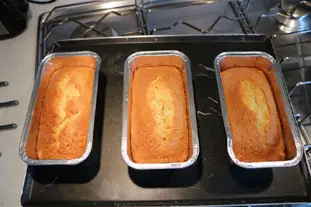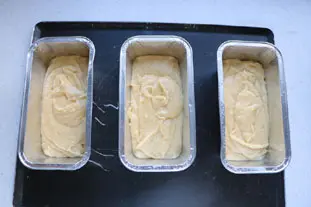This site uses only a few technical cookies necessary for its operation. By continuing to browse, you accept their use.
To find out more...
To find out more...
Baking a cake at the right time

When you make a cake, which most likely contains butter, a cake for example, chances are that as soon as the batter is finished, you put it in the pan and bake it immediately.
Classic, everyone does it like that, and then if, on top of that, you have a few kids around you who are getting impatient, and almost want it to be cooked before going in the oven, when they haven't eaten half of the raw dough before, the pressure is even stronger!
Classic, everyone does it like that, and then if, on top of that, you have a few kids around you who are getting impatient, and almost want it to be cooked before going in the oven, when they haven't eaten half of the raw dough before, the pressure is even stronger!
21 K 4.5/5 (24 reviews)
Keywords for this post:BakingCakeCookingAdviceButterColdLast modified on: April 18th 2020
Baking a cake at the right time

So baking right after you finish kneading your dough is quite classic, but actually it's not a very good thing for two reasons:
1) The butter is often very soft, especially if the kneading was a bit long and heated the dough, which becomes very soft, and if there are additions in it (raisins for example) they will go to the bottom of the pan more easily. How to correct this? Put the dough in the fridge for at least 30 minutes.
2) The gluten contained in the flour (if there is any in your recipe) under the effect of kneading has started to structure itself and "stretches" the dough making it elastic, which is not interesting for a cake because it hinders the rising during baking. How to correct this? Let the dough rest for at least 20-30 minutes.
You will have understood, no need to rush: Knead your dough, put the bowl or the mixer bowl in the fridge for 30 minutes (this is often the opportunity to do a little washing up...) then only then put it in the oven.
Another option, once the dough is kneaded, put it in a mould, then put the mould in the fridge for 30 minutes. Bake then and only then.

To sum up: Before putting a cake in the oven, it is always best to leave it in the fridge for about 30 minutes, as your cake will rise better when baked. In baking, the cold is (almost always) your friend.
Lasts posts
Butter vs. grease
We often read in a recipe where a pastry is put into a mould that, just before pouring, the mould should be buttered or greased. But what's the difference between these 2 terms?December 1st 20251,0205
Getting out of the fridge early
Very often when you're cooking, you need to take food or preparations out of the fridge, to use them in the recipe in progress. There's nothing tricky about this: you just take them out of the fridge and use them, usually immediately, in the recipe. But is this really a good method?November 24th 20251,1375
Who's making the croissants?
When you look at a bakery from the outside, you naturally think that in the bakery, the bakers make the bread, and in the laboratory, the pastry chefs make the cakes. It's very often like that, with each of these professions having quite different ways of working, but sometimes there's also one...November 23th 20251,028
Oven height
When we put a dish or cake in the oven, we naturally tend to put it on the middle shelf, and that's what we usually do. But in some cases, this position and height can be a little tricky, so let's find out why.October 8th 20252,7935
The importance of sieving
In recipes that use a fine powder (flour, powdered sugar, etc.), you'll often see the advice to sift before using it. To sift is to pass the powder in question through a sieve (a very fine strainer) before incorporating it into your recipe. It's often advice, but is it really useful?September 3rd 20257,5533
Other pages you may also like
Drawing a pattern in pastry
Often in the kitchen, in pastry-making, or in baking, we need to trace a pattern on a pastry. It's just a question of aesthetics but it has its effect after baking on a galette, pithiviers, pâté en croute (terrine in a pie crust), etc.May 23th 201935 K4.1
Kitchen ovens
You certainly have one in your kitchen, an oven, the essential tool for all kinds of cooking, whether in the kitchen of course, but also in pastry, bakery, pizza, and many others. Here is some information on its structure and operation.May 16th 202034 K4.4
No need to boil gelatin
Gelatin is a magical ingredient for making light, creamy, structured desserts, yet it's often misused in the kitchen. A common mistake in some recipes is the idea that it needs to be boiled for it to work properly, but this is a mistake indeed: gelatin melts at a much lower temperature, around...November 21th 20248,2955
Well-cooked meat
Have you ever noticed that if you like your meat well done, it invites strange looks? For instance, in a restaurant, when asked “How would you like that cooked?” If you reply, “Well done,” it is almost as if you are swearing….May 21th 201134 K 14.4
What is the difference between bakery and patisserie?
This is a question that you may well have asked yourself and which I will attempt to answer. In France the two trades of "boulangerie" (bakery) and "pâtisserie" (patisserie and confectionery) have always been quite distinct, but where exactly do the boundaries lie? .February 7th 2017134 K 14.1
Post a comment or question
Follow this page
If you are interested in this page, you can "follow" it, by entering your email address here. You will then receive a notification immediately each time the page is modified or a new comment is added. Please note that you will need to confirm this following.
Note: We'll never share your e-mail address with anyone else.
Alternatively: you can subscribe to the mailing list of cooling-ez.com , you will receive a e-mail for each new recipe published on the site.









